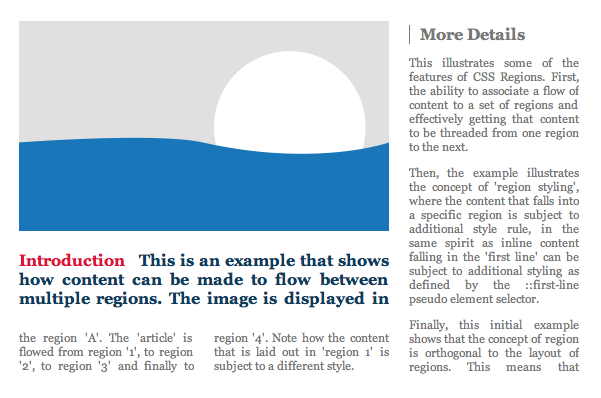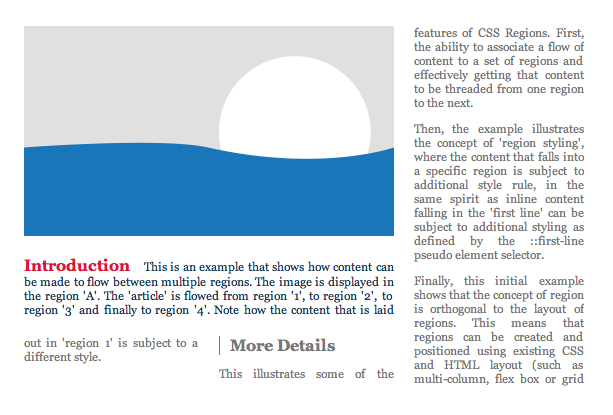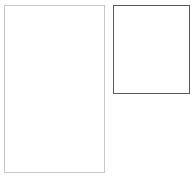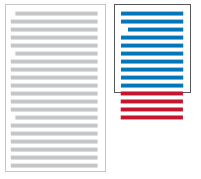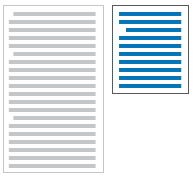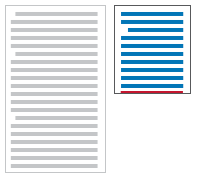Abstract
The CSS regions module allows content to flow across multiple areas
called regions. The regions are not necessarily contiguous in the document
order. The CSS regions module provides an advanced content flow mechanism,
which can be combined with positioning schemes as defined by other CSS
modules such as the Multi-Column Module [CSS3COL] or the Grid Layout Module
[CSS3-GRID-LAYOUT] to
position the regions where content flows.
Status of this
document
This document uses an experimental style sheet. We
welcome your feedback on the styles at site-comments@w3.org.
This section describes the status of this document at the time of
its publication. Other documents may supersede this document. A list of
current W3C publications and the latest revision of this technical report
can be found in the W3C technical reports
index at http://www.w3.org/TR/.
Publication as a Working Draft does not imply endorsement by the W3C
Membership. This is a draft document and may be updated, replaced or
obsoleted by other documents at any time. It is inappropriate to cite this
document as other than work in progress.
The (archived) public
mailing list www-style@w3.org (see
instructions) is preferred
for discussion of this specification. When sending e-mail, please put the
text “css3-regions” in the subject, preferably like this:
“[css3-regions] …summary of
comment…”
This document was produced by the CSS Working Group (part of
the Style Activity).
This document was produced by a group operating under the 5 February
2004 W3C Patent Policy. W3C maintains a public list of any patent disclosures made in
connection with the deliverables of the group; that page also includes
instructions for disclosing a patent. An individual who has actual
knowledge of a patent which the individual believes contains Essential
Claim(s) must disclose the information in accordance with section
6 of the W3C Patent Policy.
This draft is related to the drafts about Multi-column Layout [CSS3COL], Grid
Layout [CSS3GRID], Flexible Box Layout [CSS3-FLEXBOX], and Template
Layout [CSS3LAYOUT].
Table of contents
1. Introduction
This section is non-normative.
Capturing the complex layouts of a typical magazine, newspaper, or
textbook requires capabilities beyond those available in existing CSS
modules. This is the purpose of the CSS regions module.
The CSS regions module can be seen as an extension of the concept of
multi-column elements. With CSS Multi-column layout [CSS3COL], columns share the same
dimensions and define column boxes organized in rows. Content flows from
one column to the next.
The multi-column model is an example of flowing content from one area to
another, where the areas are the multi-column element's column boxes and
the flow is made of the multi-column element's children.
However, for more complex layouts, content needs to flow from one area
of the page to the next without limitation of the areas' sizes and
positions. These arbitrary areas are the target of specific content flows.
In this document these areas are called regions, and the content flows are
called named flows. Regions are based on the rectangular geometry of the
CSS box model. Elements in a named flow are taken out of the normal visual
formatting and rendered in a chain of regions.
1.1. Named flows
and regions
Consider the layout illustrated in figure 1.
The designer's intent is to position an image in region ‘A’ and to flow an article's text from region
‘1’, to region ‘2’, ‘3’ and
‘4’.
The following code snippet shows the content to flow between the regions
1, 2, 3 and 4.
<div id="article">
<h1>Introduction</h1>
<p>This is an example ...</p>
<h1>More Details</h1>
<p>This illustrates ...</p>
<p>Then, the example ...</p>
<p>Finally, this ...</p>
</div>
And the following snippet shows an example of elements that will be used
as regions.
<div id="region1"></div>
<div id="region2"></div>
<div id="region3"></div>
<div id="region4"></div>
CSS layout facilities can position and size regions as needed. However,
there is no existing mechanism to associate the content with the regions
so that content flows as intended. Figure 2 shows an example of the
intended visual rendering of the content.
The CSS regions module is independent of the layout of regions and the
mechanism used to create them. However, for simplicity, our example uses
elements as regions as shown in the previous code snippet.
The following code example illustrates how the content of the
article element becomes a flow and how the areas ‘region1’, ‘region2’, ‘region3’ and ‘region4’ become regions that consume the
‘article_flow’ content.
<style>
#article {
flow-into: article_flow;
}
#region1, #region2, #region3, #region4 {
flow-from: article_flow;
}
</style>
The ‘article_flow’ value on the
‘flow-into’ property directs the
‘#article’ element to the ‘article_flow’ named flow. Setting the elements'
‘flow-from’ property to ‘article_flow’ on elements makes them regions and
associates these regions with the named flow: the flow is ‘poured’ into the desired regions.
1.2. Regions styling
Region styling allows content to be styled depending on the region it
flows into. It is a form of context-based styling, similar to Media
Queries [MEDIAQ]
which enable or disable selectors depending on the rendering context. With
region styling, additional selectors may apply depending on the region
into which content flows.
In our example, the designer wants to make text flowing into region 1
larger, bold and dark blue. In addition, <h1> headers should be crimson.
This design can be expressed with region styling as shown below.
<style>
/*
* Default article styling.
*/
#article {
color:#777;
text-align: justify;
}
#article h1 {
border-left: 1px solid #777;
padding-left: 2ex;
display: run-in;
}
/*
* Additional styling to apply to content when it falls into
* region1
*/
@region #region1 {
#article {
font-weight: bold;
color: #0C3D5F;
font-size: larger;
}
#article h1 {
color: crimson;
border: none;
padding: 0px;
}
}
</style>
The ‘@region’ rule for region 1
limits its selectors to content flowing into region 1. The following
figure shows how the rendering changes if we do not increase the font size
nor make it bold for content flowing into region 1. As more content can be
fitted, more content is subject to the contextual selectors, resulting in
more dark blue text into region 1.
2. CSS regions
concepts
This section is non-normative.
2.1. Regions
A region is an element that generates
a block
container box and has an associated named
flow (see the ‘flow-from’ property).
2.2. Named flow
A named flow is the ordered sequence of
elements associated with a flow with a given identifier. Elements in a
named flow are ordered according to the document order.
Elements are placed into a named flow with the ‘flow-into’
property. The elements in a named flow are laid out in the chain of
regions that are associated with this named flow. Regions are organized in to a region chain according to the document order.
Content from a named flow is broken up between regions according to the
regions flow breaking rules.
2.3. Regions
flow breaking rules
Breaking a named flow across multiple regions is similar to breaking a
document's content across multiple pages (see [CSS3PAGE]) or a multi-column
element's content across column boxes (see [CSS3COL]). One difference is that
page boxes are generated based on the available content whereas regions
are a predefined set of recipient boxes for the named flow content.
Regions are organized in to a region chain.
Each region in turn consumes content from its associated named flow. The named flow content is positioned
in the current region
until a natural or forced region break occurs, at which point the current region becomes the
next one in the region chain. If there are
no more regions in the region chain and there is still
content in the flow, the positioning of the remaining content is
controlled by the ‘region-overflow’ property on the last
region in the chain.
3. Relation to
document events
This section is normative.
The CSS regions module does not alter the normal processing of events in
the document tree. In particular, if an event occurs on an element that is
part of a named flow, the event's
bubble and capture phases happen following the document tree order.
4. Properties and
rules
This section is normative.
4.1. The ‘flow-into’
property
The ‘flow-into’ property can place an element into a named flow.
Elements that belong to the same flow are laid out in the regions
associated with that flow.
| Name:
| flow-into
|
| Value:
| <ident> | none | inherit
|
| Initial:
| none
|
| Applies to:
| any element
|
| Inherited:
| no
|
| Percentages:
| N/A
|
| Media:
| visual
|
| Computed value:
| as specified
|
- none
- The element is not moved to a named flow and normal CSS processing
takes place.
- <ident>
- The element is placed into the flow with the name ‘
<ident>’. The element is said to have a specified flow. The values ‘none’, ‘inherit’, ‘default’, ‘auto’ and ‘initial’ are invalid flow names.
A named flow needs to be associated with one or more regions for its
elements to be visually formatted. If no region is associated with a given
named flow, the elements in the named flow are not rendered: they do not
generate boxes and are not displayed.
The children of an element with a specified flow may themselves have a
specified flow.
If an element has the same specified flow as one of its ancestors, it
becomes a sibling of it's ancestor for the purpose of layout in the
regions laying out content from that flow.
The ‘flow-into’ property does not affect the
CSS cascade and inheritance for the elements on which it is specified. The
‘flow-into’ property affects the visual
formatting of elements placed into a named flow and of regions laying out
content from a named flow.
The edges of the first region in a region chain associated with a named
flow establish the rectangle that is the initial containing block of the
named flow.
The first region defines the writing
mode for the entire flow. The writing mode on subsequent regions is
ignored.
Elements in a named flow are sequenced in document order.
This note is informative.
The ‘flow-into’ property moves an element into
the flow and the interplay with selectors should be considered carefully.
For example,
table {flow-into: table-content}
will move all tables in the ‘table-content’ named flow. However, the
table * {flow-into: table-content}
selector will move all the descendants of table elements in the
‘table-content’ named flow. This
will make all the descendants of table elements siblings in the named
flow. Having the descendants become siblings in the named flow results in
a different processing (see the CSS
2.1‘s anonymous table objects). This
note illustrates how authors must exercise caution when choosing a
particular selector for setting the ’flow-into' property to avoid
unintended results.
The ‘flow-into’ property does not apply to the
::first-line and ::first-character.
The effect of ‘flow-into’ on generated content such as
::marker, ::before and ::after is undefined. This may change depending on
implementation feedback.
4.2. The ‘flow-from’
property
The ‘flow-from’ property makes an element a
region and associates it with a named flow.
| Name:
| flow-from
|
| Value:
| <ident> | none | inherit
|
| Initial:
| none
|
| Applies to:
| Elements that generate a block
container box.
This might be expanded in future versions of the specification to allow
other types of containers to receive flow content.
|
| Inherited:
| no
|
| Percentages:
| N/A
|
| Media:
| visual
|
| Computed value:
| as specified
|
- none
- The element is not a region.
- <ident>
- If the ‘
content’ property
computes to something else than ‘normal’, the element does not become a
region. If the ‘content’ property
computes to ‘normal’, then the
element becomes a region and is ordered in a region
chain according to its document order. The content from the flow
with the <ident>
name will be broken into segments and
visually formatted in the principal
boxes of the regions in the region chain. If there is no flow with
name <ident>, then the element does not format any content
visually.
Likewise, if the element is part of the flow with name <ident>,
then the element does not format any content visually.
A region's document children are not visually formatted
unless they are directed to a named flow referenced by one or more
regions.
An element becomes a region when its ‘flow-from’ property is set to a valid
<ident> value, even if there is no content contributing to the
referenced flow. For example:
<style>
.article{
flow-into: thread;
}
.region{
flow-from: thread;
}
</style>
<html>
<body>
<div class=region>div content</div>
</body>
</html>
There is no element matching the
.article selector and
therefore no content in the
thread flow. However, the element
matching the
.region selector is still associated with that
empty named flow and, consequently, its children are not formatted
visually.
Regions create a new stacking
context. Regions establish a new block
formatting Context.
If the ‘content’ property is
defined on a region, it has no effect on the region's visual formatting.
This note is informative.
With regions, an element may be split across multiple regions and these
regions may overlap (for example if they are absolutely positioned). So
fragments of the same element can overlap each other. Since each element
has a single z-index, it would be required to find another mechanism to
decide in which order the fragments are rendered. Since each region
creates a new stacking context, it is clear that each region is rendered
separately and their rendering order follows the regular CSS rendering
model.
Floats or other exclusions (see [CSS3-EXCLUSIONS])
potentially impact the content laid out in regions, just as for
non-regions.
In the following example, the inline content coming from the body_text named flow wraps
around the #float box.
<style>
#float {
float: left;
width: 100px;
height: 300px;
}
#region1, #region2 {
width: 200px;
height: 200px;
flow-from: body_text;
}
#content {
flow-into: body_text;
}
</style>
<div id="float"></div>
<div id="region1"></div>
<div id="region2"></div>
<div id="content"></div>
4.2.1. Auto width on
regions
If a region's ‘width’ property
is computed to ‘auto’, its
resolved value is computed based on the region's ::before and
::after generated content only.
4.2.2. Auto height
on regions
If a region's ‘height’ property
is computed to ‘auto’, its
resolved value is computed based on the region's ::before and
::after generated content only.
User agents laying out content in multiple regions must determine where
content breaks occur. The problem of breaking content into segments
fitting in regions is similar to breaking content into pages or columns.
Each break ends layout in the current region and causes remaining pieces
of content from the named flow to be visually formatted in the following
region in the region chain. Note that there is no region break in the last
region associated with a named flow.
The following extends the ‘break-before’, ‘break-after’ and
‘break-inside’ properties from the [CSS3COL]
specification to account for regions. The additional values are described
below.
| Name:
| break-before
|
| Value:
| auto | always | avoid | left | right | page | column | region |
avoid-page | avoid-column | avoid-region
|
| Initial:
| auto
|
| Applies to:
| block-level elements
|
| Inherited:
| no
|
| Percentages:
| N/A
|
| Media:
| paged
|
| Computed value:
| specified value
|
| Name:
| break-after
|
| Value:
| auto | always | avoid | left | right | page | column | region |
avoid-page | avoid-column | avoid-region
|
| Initial:
| auto
|
| Applies to:
| block-level elements
|
| Inherited:
| no
|
| Percentages:
| N/A
|
| Media:
| paged
|
| Computed value:
| specified value
|
| Name:
| break-inside
|
| Value:
| auto | avoid | avoid-page | avoid-column | avoid-region
|
| Initial:
| auto
|
| Applies to:
| block-level elements
|
| Inherited:
| no
|
| Percentages:
| N/A
|
| Media:
| paged
|
| Computed value:
| specified value
|
These properties describe page, column and region break behavior
before/after/inside the generated box. These values are normatively
defined in [CSS3COL]:
- auto
- Neither force nor forbid a page/column break before (after, inside)
the generated box.
- always
- Always force a page break before (after) the generated box.
- avoid
- Avoid a page/column break before (after, inside) the generated box.
- left
- Force one or two page breaks before (after) the generated box so that
the next page is formatted as a left page.
- right
- Force one or two page breaks before (after) the generated box so that
the next page is formatted as a right page.
- page
- Always force a page break before (after) the generated box.
- column
- Always force a column break before (after) the generated box.
- avoid-page
- Avoid a page break before (after, inside) the generated box.
- avoid-column
- Avoid a column break before (after, inside) the generated box.
This specification adds the following new values:
- region
- Always force a region break before (after) the generated box.
- avoid-region
- Avoid a region break before (after, inside) the generated box.
When a break splits a box, the box's margins, borders, and padding have
no visual effect where the split occurs. However, the margin immediately
after a forced page/column/region break will be preserved. A forced
page/column/region break is a break that does not occur naturally.
Note: When the ‘avoid’ value is used, regions may overflow. In
that case the ‘overflow’ property specified on the region
element should be used to determine how to render the overflow.
4.4. The
region-overflow property
| Name:
| region-overflow
|
| Value:
| auto | break
|
| Initial:
| auto
|
| Applies to:
| region elements
|
| Inherited:
| no
|
| Percentages:
| N/A
|
| Media:
| paged
|
| Computed value:
| specified value
|
The ‘region-overflow’ property controls the
behavior of the last region associated with a named flow.
- auto
- Content flows as it would in a regular content element. If the content
exceeds the container box, it is subject to the overflow
property's computed value on the region element. Region breaks must be
ignored on the last region.
- break
-
If the content fits within the region element, then this
property has no effect. If the content does not fit within the
region element, the content breaks as if flow was going to
continue in a subsequent region. See the breaking rules section. A forced
region break takes precedence over a natural break point.
Flow content that follows the last break in the last region, if any is
not rendered.
The ‘region-overflow’ property does not
influence the size of the region it applies to.
The following code sample illustrates the usage of the ‘region-overflow’ property.
<style>
#article {
flow-into: "article";
}
#region_1, #region_2 {
flow-from: article;
region-overflow: break; /* or none */
overflow: visible; /* or hidden */
}
</style>
<div id="article">...</div>
<div id="region_1"></div>
<div id="region_2"></div>
The ‘overflow’ property is honored on a
region: if region content overflows, such as the borders of elements on
the last line, the ‘overflow’ property controls the
visibility of the overflowing content. See the ‘overflow’ property definition ([CSS21]).
4.5. The @region
rule
An ‘@region’ rule contains style
declarations specific to particular regions.
@region <selector> {
... CSS styling rules ...
}
The ‘@region’ rule consists of the
keyword ‘@region’ followed by a selector
and a declarations block. The ‘@region’
rule and the selector constitute the region's ‘flow
segment’ selector. The region's flow segment selector
specifies which range of elements in the flow are subject to the following
declaration blocks: it applies to the range (see [DOM-LEVEL-2-TRAVERSAL-RANGE])
from the region's flow that flows in the selected region(s).
Elements that are fully or partially in the ‘flow
segment’ may match any of the selectors found in the style
rule.
Only a limited list of properties can be set in a region style rule:
- font properties
- color property
- background
property
- ‘
word-spacing’
- ‘
letter-spacing’
- ‘
text-decoration’
- ‘
text-transform’
- ‘
line-height’
- border
properties
- rounded corner
properties
- border
images properties
- margin
properties
- padding
properties
- ‘
text-shadow’ property
- ‘
box-shadow’ property
- ‘
box-decoration-break’ property
- ‘
width’ property
In the following example, the named flow ‘article_flow’ flows through ‘region_1’ and ‘region_2’.
<style>
#div_1 {
flow-into: article_flow;
}
<region1_sel>, <region2_sel> {
flow-from: article_flow;
}
/* region style RSA */
@region <region1_sel>, <region2_sel> {
div {...}
p {...}
}
/* region style RSB */
@region <region1_sel> {
p {...}
}
</style>
<div id="div_1">
<p id="p_1">...</p>
<p id="p_2">...</p>
</div>
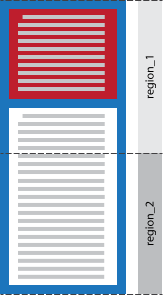
- div div_1
- paragraph
p_1
- paragraph
p_2
- range of
flow that fits into region_1
- range of
flow that fits into region_2
The region style ‘RSA’ applies to
flow content that is laid out in either ‘region_1’ or ‘region_2’.
The first rule set ‘div {...}’
applies to all <div> elements that fit
partially or fully into ‘region_1’ or
‘region_2’. div_1 is split between ‘region_1’ and ‘region_2’ and gets the style from this style rule.
The second rule set ‘p {...}’
applies to all <p> elements that fit into
‘region_1’ or ‘region_2’. In our example, both p_1 and p_2 are selected.
The region style ‘RSB’ applies to
flow content that fits in ‘region_1’.
The first rule set ‘p {...}’ matches
p_1 and p_2 because these
paragraphs flow into ‘region_1’. Only
the segment of p_2 that flows into region_1 is styled with this rule.
Making issue stale because this issue has not been raised on the
mailing list and we will wait for implementation feedback. Is the
proposed restriction that elements are only selected selector in a rule
set appearing in an @region rule sufficient?
Moved
to specification Wiki. There is
concern
that the ‘
first-line’ precedent is
underspecified and that more specification is needed in addition to
referencing the existing precedent.
The specificity of the selectors in a ‘@region’ rule is calculated as defined in the
CSS Selectors module (see [SELECT]). In other words, the
‘@region’ rule adds an extra condition
to the selector's matching, but does not change the selector's
specificity. This is the same behavior as selectors appearing in
‘@media’ rules declaration blocks (see
[MEDIAQ]), where
the rule does not influence the selectors' specificity.
Consequently, selectors that match a given element (as describe above),
participate in the CSS
Cascading order as defined in [CSS21].
Region styling does not apply to nested regions. If a
region ‘A’ receives content from a
flow that contains region ‘B’, the
content that flows into ‘B’ does
not receive the region styling specified for region ‘A’.
5. Pseudo-elements
This section is normative.
It can be useful to visually mark the content to highlight that a
content thread is flowing from region to region. For example, a marker
such as ‘continues on page 3’
clearly indicates, at the end of a region, that there is more content in
the flow which can be found on ‘page 3’
(in this example, the notion of page is application specific).
The ‘::before’ and ‘::after’ pseudo-elements (see [SELECT]) let content authors mark
the beginning and end of a region with such markers.
5.1. Processing model
The ‘::before’ content is laid out in
the region prior to any other content coming from the flow. Note that it
is possible to set the ‘::before’
pseudo-element's ‘display’
property to ‘run-in’ to align it
with the content's inline boxes.
The ‘::after’ content is laid out in
the region after laying out the flow content. Then, flow content is
removed from the region to accommodate for the ‘::after’ content. Accommodating means that the
‘::after’ content is laid out without
overflowing the region. If there is still not enough room to accommodate
for the ‘::after’ content after
removing all flow content, then the ‘::after’ content overflows. The ‘display’ property of the ‘::after’ content should be set to ‘run-in’ to align with the region's content's
inline boxes. In that case, the ‘::after’ content becomes the last inline box of the
previous element in the flow that has some visual rendering in the region
and can accommodate for the ‘::after’
box.
6. CSSOM view
and CSS regions
This section is normative.
Since content may flow into multiple regions, authors need a way to
determine if there are enough regions to flow all the content from a named
flow. This is especially important considering that the size of regions
may change depending on the display context. For example, flowing the same
content on a mobile phone with a small screen may require more regions
than on a large desktop display.
Another example where creating more regions might be needed: if the user
may change the font size of text flowing through regions, new regions may
be needed to accommodate for the additional space required to fit the
larger text or some regions may need to be removed for smaller text.
Since an element may be split into multiple regions, invoking getClientRects
on it must return the list of rectangles for the element in all the
regions it is part of.
6.1. The NamedFlow
interface
The getFlowByName method on the Document interface provides access to the document's
named flow instances.
[Supplemental] interface Document {
NamedFlow
getFlowByName(DOMString name);
};
The NamedFlow
interface offers a representation of the named
flow.
interface NamedFlow {
readonly attribute boolean overflow;
readonly attribute NodeList contentNodes;
NodeList getRegionsByContentNode(Node node);
};
};
The overflow
property is true if the named flow does not fully fit in the associated
regions. Otherwise, it is false. A NamedFlow object is live.
The contentNodes property
returns an ordered collection of nodes that constitute the named flow.
Note that this collection is live: every time it is queried it must return
the same object, and the object is always up to date.
The getRegionsByContentNode()
method gets a collection of regions that contain at least part of the
target content node. This can be used to navigate by bookmark in paginated
view: the method returns regions containing the bookmarked element, which
are then passed to pagination UI to show desired region or page.
With the NamedFlow
interface, authors can easily check if all content has been fitted into
existing regions. If it has, the overflow property would be false.
6.2.
Extension to the Element interface
When an region is an actual element,
it is convenient to easily find out if content fully fits into the
region or not. The supplemental interface on Element provides that functionality.
[Supplemental] interface Element {
readonly attribute DOMString regionOverflow;
getter Range[] getRegionFlowRanges();
};
The regionOverflow attribute can take one of the
following values:
- ‘
overflow’
- the region element's content overflows the region's content
box. Note that the region's
overflow property value can be used to control the
visibility of the overflowing content. This means that the region is the
last one in the region chain and not able
to fit the remaining content from the named
flow.
- ‘
fit’
- the region element's content fits into the region's content
box. It does not overflow. If the region is the last one in the region chain, it means that the content fits
without overflowing. If the region is not the last one in the region
chain, that means the named flow content is
further fitted in subsequent regions. In particular, in this last case,
that means the region may have received no content from the named flow (for example if the region is too
small to accommodate any content).
- ‘
empty’
- the region element has no content and is empty. All content from the
named flow was fitted in regions with a lower
document order.
- ‘
undefined’
- The element is not a region.
The getRegionFlowRanges
method returns an array of
Range instances corresponding to the content from the region flow that
is positioned in the region.
If an element is not a region, the getRegionFlowRanges
method throws a DOMException with the INVALID_ACCESS_ERR error code.
The Element interface extension is only available to
regions that are document elements and not to regions that are
pseudo-elements.
ACTION-350 was
created to add the API to the specification draft.
It has been suggested
to add an API to find which region displays an element in a named flow.
Should we add such an API? How would it work in a ‘multi-view’ context as suggested by Alex.
6.3. Region flow
layout events
Region Event
Targets dispatch regionLayoutUpdate events when
there is a possible layout change of their named flow segment.
| Type
| regionLayoutUpdate
|
| Interface
| UIEvent
|
| Sync / Async
| Async
|
| Bubbles
| Yes
|
| Target
| Element
|
| Cancelable
| Yes
|
| Default action
| none
|
| Context info
|
Event.target: region whose
layout may have changed
|
7.
Relation to other specifications
This specification is related to other specifications as described in
the references section. In addition, it is
related to the following specifications:
- CSS Exclusions Module [CSS3-EXCLUSIONS]. This
module defines a generic way to define arbitrarily shaped exclusions into
which content can flow or around which content can flow. This can be seen
as an extension to the way CSS floats provide rectangular areas into
which content flows and around which content flows. In advanced layout
designs, it is expected that the CSS Exclusions module will be commonly
combined with the CSS regions module.
- CSS Line Grid Module [CSS3-LINE-GRID]. This
module defines a concept of line grid to align the position of lines in
different elements. The line grid functionality is related and needed for
aligning content flowing in separate regions.
8. Use Cases
Use cases are described on this
page.
10. Changes
- Editorial changes (typos, rephrasings).
- Made ‘
content-order’ a
<integer> and not a <float> following a working group resolution
- Added Alex Mogilevsky as an editor
- Flow names became <ident> instead of <string> following a
working group resolution
- Removed issue about possibly altering the DOM Events model for region
events following a working group resolution
- Made the "relation to document events" section informative following a
working group resolution
- Removed issue in section "The NamedFlow interface" following the
working group's resolution
to have both NamedFlow and the Element interface extension
- Following a working group resolution:
- Turned the first issue in the "Extensions to the Element interface"
into a note explaining that the NamedFlow interface can be used when
regions are pseudo-elements.
- Added NamedFlowUpdate
- Excluded ‘
none’, ‘inherit’ and ‘initial’ from the possible identifier names
on the flow property following discussion
on the mailing list.
- Simplified integration discussion on multi-column layout and just
state that since column boxes are not addressable by selectors, they
cannot be regions.
- Added specification of how the ‘
flow-into’ property interacts with
object, embed and iframe elements.
- Excluded ‘
default’ from the
possible identifier names on the flow property because it may
get reserved.
- Added to the definition of ‘
auto’ on ‘region-overflow’ specifying that region
breaks must be ignored.
- Renamed ‘
Document.flowWithName’ to
‘Document.getFlowByName’ since it is
not a property.
- Added a note that a ‘
NamedFlow’ instance is live.
- Added an ‘
undefined’ string
value to the regionOverflow property on the Element interface extension.
- Renamed NamedFlowEvent to regionLayoutUpdate to avoid having
‘
Event’ in the event name.
- Added description for special behavior of iframe/object/embed as flow
source
- Removed issue on copying content to a named flow instead of moving
elements to named flow following working group resolution.
- Removed issue on content:flow-from v.s., flow-from property following
working group resolution.
- Renamed ‘
flow’ to ‘flow-into’
following working group resolution.
- Updated the css3-grid-align example following working group resolution
that it should use <div> instead of grid-cell pseudo elements that
were removed from the CSS Grid Layout specification.
- Renamed ‘
from-flow’ to
‘flow-from’ following a working group resolution.
- Limited the applicability of ‘
content:
flow-from()’ to block container box and added a note that
this might be expanded in the future, following a working group resolution.
- Removed issue about API to find which region displays an element in a
named flow since ACTION-350 was
created to add this API.
- In the ‘
flow’ property
description, removed the required wrapper anonymous block as agreed on mailing
list discussion.
- Reworded the paragraph on how regions create a new stacking context,
as per the mailing
list discussion.
- Reworked the "CSS regions Model" section to now be "CSS regions
Layout". Moved the definition of a region as the first sub-section.
- Removed the "Visual Formatting Model and Flows" section to match the
new Regions Model (now CSS regions Layout) section.
- Moved the sections on allowed region breaks, forced region breaks and
"best" regions breaks to follow the property definitions to follow the
formatting of the paged media section in CSS 2.1.
- Added note about why regions create a new stacking context following
the discussion on the mailing
list.
- Removed sentence about content:none making elements disconnected
following the discussion on the mailing
list.
- Removed sentence about content:none making elements disconnected
following the discussion on the mailing
list.
- Added the ::region-before and a ::region-after pseudo-elements.
- Added note of caution when using selectors and the ‘
flow-into’
property following a mailing
list discussion.
- Removed sections about allowed, forced and best region breaks to align
with the multi-column specification approach and until the group agrees
on where and how the general issue of breaks (regions/pages/columns)
should be addressed.
- Removed the section on Integration with other specifications since
specifications that was superfluous especially since there is no specific
integration with multi column, grid or template layout.
- Added a note that regions establish a new block formatting context.
- Renamed content-order to region-order.
- Added a note about overflowing content in regions (e.g., for content
with borders).
- Added a note that a region cannot layout content it is part of (to
avoid creating a circular dependency) in the flow-from description,
specifying that if flow-from references the flow an element is part of,
then the element does not format anything visually.
- Replaced ‘
content:flow-from(<ident>)’ with
‘flow-from: <ident>’ following a
working group
resolution.
- Added more specific wording about auto width and auto height,
following ACTION 351.
- Reworked section on region markers to now use ‘
::before’ and ‘::after’ and explain how ‘display:run-in’ works with regions.
- Modified the @region style rule to remove the ::region-lines
pseudo-selector.
- Removed the ‘
region-order’
property following implementation feedback.
- Specified that region-overflow does not influence a region's size.
- Specified that the flow's writing mode is defined by the first
region's writing mode following mailing
list discussion.
- Made iframe, object and embed support of flow-into optional following
mailing
list discussion.
- Clarified that flow content following the last break in the last
region is not rendered, following mailing
list discussions.
- Modified the rule for computing the width and height of a region when
they are set to auto, following a
mailing list discussion.
- Added ‘
auto’ to the list of
invalid flow identifiers.
- Made ‘
none’ the initial value
for ‘flow-into’ and aligned with ‘flow-from’, as
explained in this email.
Also allowed the ‘inherit’ value
on ‘flow-from’ and ‘flow-into’ (same
email).
- Added note about nested region styling following a
mailing list discussion.
- Added additional DOM interface following Action 350.
- Clarified that a region becomes a region only if its ‘
content’ property computes to normal,
following the resolution of Issue
22.
- Removed text about special iframe behavior as a result of ACTION 376.
- Made the selectors explicit in the initial section code examples,
following discussion in San Jose, October
2011 face to face meeting.
- Added section on use cases following ACTION-377.
Acknowledgments
The editors are grateful to the CSS working group for their feedback and
help with the genesis of this specification.
In addition, the editors would like to thank the following individuals
for their contributions, either during the conception of CSS regions or
during its development and specification review process:
- Rossen Atanassov, Microsoft Corporation.
- Andrei Bucur, Adobe Systems, Inc.
- Alexandru Chiculita, Adobe Systems, Inc.
- Arno Gourdol, Adobe Systems, Inc.
- Mihnea Ovidenie, Adobe Systems, Inc.
- Virgil Palanciuc, Adobe Systems, Inc.
- Christoph Päper
- Anton Prowse, Invited Expert.
- Peter Sorotokin, Adobe Systems, Inc.
- Alan Stearns, Adobe Systems, Inc.
- Stephen Zilles, Adobe Systems, Inc.
- David Hyatt, Apple Inc.
References
Normative references
-
- [CSS21]
- Bert Bos; et al. Cascading Style
Sheets Level 2 Revision 1 (CSS 2.1) Specification. 7 June
2011. W3C Recommendation. URL: http://www.w3.org/TR/2011/REC-CSS2-20110607
- [CSS3COL]
- Håkon Wium Lie. CSS
Multi-column Layout Module. 12 April 2011. W3C Candidate
Recommendation. (Work in progress.) URL: http://www.w3.org/TR/2011/CR-css3-multicol-20110412
- [SELECT]
- Tantek Çelik; et al. Selectors
Level 3. 29 September 2011. W3C Recommendation. URL: http://www.w3.org/TR/2011/REC-css3-selectors-20110929/
Other references
-
- [CSS3-EXCLUSIONS]
- Vincent Hardy. CSS Exclusions
Module. Proposal for a CSS module. (Retrieved 15 November
2011) URL: http://dev.w3.org/csswg/css3-exclusions/
- [CSS3-FLEXBOX]
- Tab Atkins Jr.; Alex Mogilevsky; L. David Baron. Flexible
Box Layout Module. 22 March 2011. W3C Working Draft. (Work in
progress.) URL: http://www.w3.org/TR/2011/WD-css3-flexbox-20110322/
- [CSS3-GRID-LAYOUT]
- Alex Mogilevsky; et al. Grid
Layout. 7 April 2011. W3C Working Draft. (Work in progress.)
URL: http://www.w3.org/TR/2011/WD-css3-grid-layout-20110407
- [CSS3-LINE-GRID]
- Koji Ishii. CSS
Line Grid Module. Proposal for a CSS module. (Retrieved 26
October 2011) URL: http://dev.w3.org/csswg/css-line-grid/
- [CSS3GRID]
- Alex Mogilevsky; Markus Mielke. CSS Grid
Positioning Module Level 3. 5 September 2007. W3C Working
Draft. (Work in progress.) URL: http://www.w3.org/TR/2007/WD-css3-grid-20070905
- [CSS3LAYOUT]
- Bert Bos; César Acebal. CSS
Template Layout Module. 29 April 2010. W3C Working Draft.
(Work in progress.) URL: http://www.w3.org/TR/2010/WD-css3-layout-20100429
- [CSS3PAGE]
- Håkon Wium Lie; Melinda Grant. CSS3 Module:
Paged Media. 10 October 2006. W3C Working Draft. (Work in
progress.) URL: http://www.w3.org/TR/2006/WD-css3-page-20061010
- [DOM-LEVEL-2-TRAVERSAL-RANGE]
- Joe Kesselman; et al. Document
Object Model (DOM) Level 2 Traversal and Range Specification.
13 November 2000. W3C Recommendation. URL: http://www.w3.org/TR/2000/REC-DOM-Level-2-Traversal-Range-20001113
- [MEDIAQ]
- Håkon Wium Lie; et al. Media
Queries. 27 July 2010. W3C Candidate Recommendation. (Work in
progress.) URL: http://www.w3.org/TR/2010/CR-css3-mediaqueries-20100727/
Index
- break-after, 4.3.
- break-before, 4.3.
- break-inside, 4.3.
- contentNodes, 6.1.
- current-region, 2.3.
- flow-from, 4.2.
- flow-into, 4.1.
- getRegionFlowRanges, 6.2.
- getRegionsByContentNode(), 6.1.
NamedFlow, 6.1.
- named flow, 2.2.
overflow,
6.1.
- region, 2.1.
regionOverflow, 6.2.
- region-overflow, 4.4.
- specified flow, 4.1.
Property index
